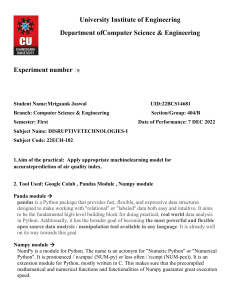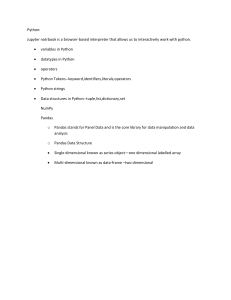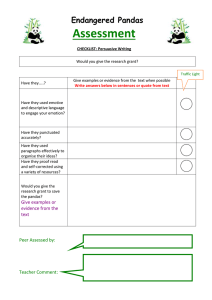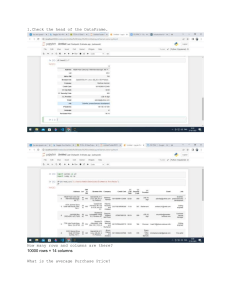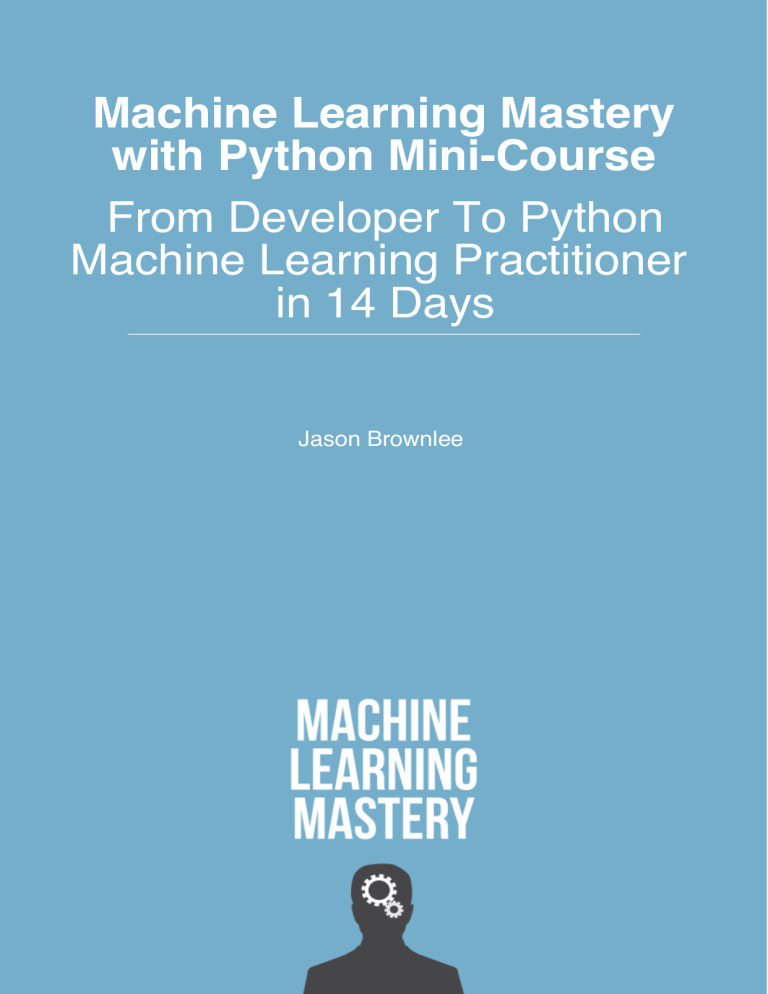
������������������������
�����������������������
�������������������������
������������������������������
����������
��������������
Jason Brownlee
Machine Learning Mastery with
Python Mini-Course
From Developer To Machine Learning Practitioner in 14 Days
i
Machine Learning Mastery with Python Mini-Course
© Copyright 2016 Jason Brownlee. All Rights Reserved.
Edition: v1.0
Find the latest version of this guide online at: http://MachineLearningMastery.com
Contents
Before We Get Started...
1
Lesson 1: Download and Install Python and SciPy Ecosystem
3
Lesson 2: Get Around In Python, NumPy, Matplotlib and Pandas
4
Lesson 3: Load Data From CSV
5
Lesson 4: Understand Data with Descriptive Statistics
6
Lesson 5: Understand Data with Visualization
7
Lesson 6: Prepare For Modeling by Pre-Processing Data
8
Lesson 7: Algorithm Evaluation With Resampling Methods
9
Lesson 8: Algorithm Evaluation Metrics
10
Lesson 9: Spot-Check Algorithms
11
Lesson 10: Model Comparison and Selection
12
Lesson 11: Improve Accuracy with Algorithm Tuning
14
Lesson 12: Improve Accuracy with Ensemble Predictions
15
Lesson 13: Finalize And Save Your Model
16
Lesson 14: Hello World End-to-End Project
17
Final Word Before You Go...
18
ii
Before We Get Started...
In this mini-course you will discover how you can get started, build accurate models and
confidently complete predictive modeling machine learning projects using Python in 14 days.
This is a long and useful guide. You might want to print it out.
Who Is This Mini-Course For?
Before we get started, let’s make sure you are in the right place. The list below provides some
general guidelines as to who this course was designed for. Don’t panic if you don’t match these
points exactly, you might just need to brush up in one area or another to keep up.
Developers that know how to write a little code. This means that it is not a big
deal for you to pick up a new programming language like Python once you know the basic
syntax. It does not mean your a wizard coder, just that you can follow a basic C-like
language with little effort.
Developers that know a little machine learning. This means you know about the
basics of machine learning like cross validation, some algorithms and the bias-variance
trade-off. It does not mean that you are a machine learning PhD, just that you know the
landmarks or know where to look them up.
This mini-course is neither a textbook on Python or a textbook on machine learning. It
will take you from a developer that knows a little machine learning to a developer who can get
results using Python, one of the most powerful and popular platforms for machine learning.
Mini-Course Overview (what to expect)
This mini-course is broken down into 14 lessons. You could complete one lesson per day
(recommended) or complete all of the lessons in one day (hard core!). It really depends on the
time you have available and your level of enthusiasm. Below are 14 lessons that will get you
started and productive with machine learning in Python:
Lesson 1: Download and Install Python and SciPy Ecosystem.
Lesson 2: Get Around In Python, NumPy, Matplotlib and Pandas.
Lesson 3: Load Data From CSV.
1
2
Lesson 4: Understand Data with Descriptive Statistics.
Lesson 5: Understand Data with Visualization.
Lesson 6: Prepare For Modeling by Pre-Processing Data.
Lesson 7: Algorithm Evaluation With Resampling Methods.
Lesson 8: Algorithm Evaluation Metrics.
Lesson 9: Spot-Check Algorithms.
Lesson 10: Model Comparison and Selection.
Lesson 11: Improve Accuracy with Algorithm Tuning.
Lesson 12: Improve Accuracy with Ensemble Predictions.
Lesson 13: Finalize And Save Your Model.
Lesson 14: Hello World End-to-End Project.
Each lesson could take you 60 seconds or up to 30 minutes. Take your time and complete
the lessons at your own pace. The lessons expect you to go off and find out how to do things. I
will give you hints, but part of the point of each lesson is to force you to learn where to go to
look for help on and about the Python platform (hint, I have all of the answers directly on my
blog1 , use the search). I do provide more help in the early lessons because I want you to build
up some confidence and inertia.
Hang in there, don’t give up!
If you would like me to step you through each lesson in great detail, take a look at my book:
Machine Learning Mastery with Python:
https://machinelearningmastery.com/machine-learning-with-python/
1
http://MachineLearningMastery.com
Lesson 1: Download and Install Python
and SciPy Ecosystem
You cannot get started with machine learning in Python until you have access to the platform.
Todays lesson is easy, you must download and install the Python 2.7 platform on your computer.
Visit the Python homepage2 and download Python for your operating system (Linux, OS
X or Windows). Install Python on your computer. You may need to use a platform specific
package manager such as macports on OS X or yum on RedHat Linux.
You also need to install the SciPy platform3 and the scikit-learn library. I recommend using
the same approach that you used to install Python. You can install everything at once (much
easier) with Anaconda4 . Anaconda is recommended for beginners.
Start Python for the first time from command line by typing python at the command line.
Check the versions of everything you are going to need using the code below:
1
2
3
4
5
6
7
8
9
10
11
12
13
14
15
16
17
18
# Python version
import sys
print('Python: {}'.format(sys.version))
# scipy
import scipy
print('scipy: {}'.format(scipy.__version__))
# numpy
import numpy
print('numpy: {}'.format(numpy.__version__))
# matplotlib
import matplotlib
print('matplotlib: {}'.format(matplotlib.__version__))
# pandas
import pandas
print('pandas: {}'.format(pandas.__version__))
# scikit-learn
import sklearn
print('sklearn: {}'.format(sklearn.__version__))
Listing 1: Print the versions of Python and the SciPy libraries.
If there are any errors, stop. Now is the time to fix them.
2
https://www.python.org/
http://scipy.org/
4
https://www.continuum.io/downloads
3
3
Lesson 2: Get Around In Python,
NumPy, Matplotlib and Pandas
You need to be able to read and write basic Python scripts. As a developer you can pick-up new
programming languages pretty quickly. Python is case sensitive, uses hash (#) for comments
and uses white space to indicate code blocks (white space matters). Todays task is to practice
the basic syntax of the Python programming language and important SciPy data structures in
the Python interactive environment.
1. Practice assignment, working with lists and flow control in Python.
2. Practice working with NumPy arrays.
3. Practice creating simple plots in Matplotlib.
4. Practice working with Pandas Series and DataFrames.
For example, below is a simple example of creating a Pandas DataFrame.
1
2
3
4
5
6
7
8
# dataframe
import numpy
import pandas
myarray = numpy.array([[1, 2, 3], [4, 5, 6]])
rownames = ['a', 'b']
colnames = ['one', 'two', 'three']
mydataframe = pandas.DataFrame(myarray, index=rownames, columns=colnames)
print(mydataframe)
Listing 2: Create a Pandas DataFrame.
4
Lesson 3: Load Data From CSV
Machine learning algorithms need data. You can load your own data from CSV files but when
you are getting started with machine learning in Python you should practice on standard
machine learning datasets. Your task for todays lesson are to get comfortable loading data into
Python and to find and load standard machine learning datasets. There are many excellent
standard machine learning datasets in CSV format that you can download and practice with on
the UCI machine learning repository5 .
Practice loading CSV files into Python using the CSV.reader()6 function in the standard
library.
Practice loading CSV files using NumPy and the numpy.loadtxt()7 function.
Practice loading CSV files using Pandas and the pandas.read csv()8 function.
To get you started, below is a snippet that will load the Pima Indians onset of diabetes
dataset using Pandas directly from the UCI Machine Learning Repository.
1
2
3
4
5
6
# Load CSV using Pandas from URL
import pandas
url = "https://goo.gl/vhm1eU"
names = ['preg', 'plas', 'pres', 'skin', 'test', 'mass', 'pedi', 'age', 'class']
data = pandas.read_csv(url, names=names)
print(data.shape)
Listing 3: Load a CSV dataset from a URL.
Well done for making it this far! Hang in there.
5
http://archive.ics.uci.edu/ml/
https://docs.python.org/2/library/csv.html
7
http://docs.scipy.org/doc/numpy-1.10.0/reference/generated/numpy.loadtxt.html
8
http://pandas.pydata.org/pandas-docs/stable/generated/pandas.read_csv.html
6
5
Lesson 4: Understand Data with
Descriptive Statistics
Once you have loaded your data into Python you need to be able to understand it. The better
you can understand your data, the better and more accurate the models that you can build.
The first step to understanding your data is to use descriptive statistics. Today your lesson is to
learn how to use descriptive statistics to understand your data. I recommend using the helper
functions provided on the Pandas DataFrame.
Understand your data using the head() function to look at the first few rows.
Review the dimensions of your data with the shape property.
Look at the data types for each attribute with the dtypes property.
Review the distribution of your data with the describe() function.
Calculate pair-wise correlation between your variables using the corr() function.
The below example loads the Pima Indians onset of diabetes dataset and summarizes the
distribution of each attribute.
1
2
3
4
5
6
7
# Statistical Summary
import pandas
url = "https://goo.gl/vhm1eU"
names = ['preg', 'plas', 'pres', 'skin', 'test', 'mass', 'pedi', 'age', 'class']
data = pandas.read_csv(url, names=names)
description = data.describe()
print(description)
Listing 4: Print Descriptive Statistics for a Dataset.
Try it out!
6
Lesson 5: Understand Data with
Visualization
Continuing on from yesterdays lesson, you must spend time to better understand your data. A
second way to improve your understanding of your data is by using data visualization techniques
(e.g. plotting). Today, your lesson is to learn how to use plotting in Python to understand
attributes alone and their interactions. Again, I recommend using the helper functions provided
on the Pandas DataFrame.
Use the hist() function to create a histogram of each attribute.
Use the plot(kind=’box’) function to create box and whisker plots of each attribute.
Use the pandas.scatter matrix() function to create pair-wise scatter plots of all attributes.
For example the snippet below will load the iris dataset and create a scatter plot matrix of
the dataset.
1
2
3
4
5
6
7
8
9
# Scatter Plot Matrix
import matplotlib.pyplot as plt
import pandas
from pandas.tools.plotting import scatter_matrix
url = "https://goo.gl/vhm1eU"
names = ['preg', 'plas', 'pres', 'skin', 'test', 'mass', 'pedi', 'age', 'class']
data = pandas.read_csv(url, names=names)
scatter_matrix(data)
plt.show()
Listing 5: Create and Display a Scatter Plot Matrix.
7
Lesson 6: Prepare For Modeling by
Pre-Processing Data
Your raw data may not be setup to be in the best shape for modeling. Sometimes you need to
pre-process your data in order to best present the inherent structure of the problem in your
data to the modeling algorithms. In today’s lesson, you will use the pre-processing capabilities
provided by the scikit-learn.
The scikit-learn library provides two standard idioms for transforming data. Each are useful
in different circumstances: Fit and Multiple Transform and Combined Fit-And-Transform.
There are many techniques that you can use to prepare your data for modeling, for example try
out some of the following:
Standardize numerical data (e.g. mean of 0 and standard deviation of 1) using the scale
and center options.
Normalize numerical data (e.g. to a range of 0-1) using the range option.
Explore more advanced feature engineering such as Binarizing.
For example, the snippet below loads the Pima Indians onset of diabetes dataset, calculates
the parameters needed to standardize the data, then creates a standardize copy of the input
data.
1
2
3
4
5
6
7
8
9
10
11
12
13
14
15
16
# Standardize data (0 mean, 1 stdev)
from sklearn.preprocessing import StandardScaler
import pandas
import numpy
url = "https://goo.gl/vhm1eU"
names = ['preg', 'plas', 'pres', 'skin', 'test', 'mass', 'pedi', 'age', 'class']
dataframe = pandas.read_csv(url, names=names)
array = dataframe.values
# separate array into input and output components
X = array[:,0:8]
Y = array[:,8]
scaler = StandardScaler().fit(X)
rescaledX = scaler.transform(X)
# summarize transformed data
numpy.set_printoptions(precision=3)
print(rescaledX[0:5,:])
Listing 6: Standardize a Dataset.
8
Lesson 7: Algorithm Evaluation With
Resampling Methods
The dataset used to train a machine learning algorithm is called a training dataset. The dataset
used to train an algorithm cannot be used to give you reliable estimates of the accuracy of the
model on new data. This is a big problem because the whole idea of creating the model is to
make predictions on new data. You can use statistical methods called resampling methods to
split your training dataset into subsets, some are used to train the model and others are held
back and used to estimate the accuracy of the model on unseen data.
Your goal with todays lesson is to practice using the different resampling methods available
in scikit-learn, for example:
Split a dataset into training and test sets.
Estimate the accuracy of an algorithm using k-fold cross validation.
Estimate the accuracy of an algorithm using leave one out cross validation.
The snippet below uses scikit-learn to estimate the accuracy of the Logistic Regression
algorithm on the Pima Indians onset of diabetes dataset using 10-fold cross validation.
1
2
3
4
5
6
7
8
9
10
11
12
13
14
15
16
17
# Evaluate using Cross Validation
import pandas
from sklearn import cross_validation
from sklearn.linear_model import LogisticRegression
url = "https://goo.gl/vhm1eU"
names = ['preg', 'plas', 'pres', 'skin', 'test', 'mass', 'pedi', 'age', 'class']
dataframe = pandas.read_csv(url, names=names)
array = dataframe.values
X = array[:,0:8]
Y = array[:,8]
num_folds = 10
num_instances = len(X)
seed = 7
kfold = cross_validation.KFold(n=num_instances, n_folds=num_folds, random_state=seed)
model = LogisticRegression()
results = cross_validation.cross_val_score(model, X, Y, cv=kfold)
print("Accuracy: %.3f%% (%.3f%%)") % (results.mean()*100.0, results.std()*100.0)
Listing 7: Estimate the Accuracy of an Algorithm with K-fold Cross Validation.
Did you realize that this is the half-way point? Well done!
9
Lesson 8: Algorithm Evaluation
Metrics
There are many different metrics that you can use to evaluate the skill of a machine learning
algorithm on a dataset.
You can specify the metric used for your test harness in scikit-learn via the cross val score()
function and defaults can be used for regression and classification problems. Your goal with
todays lesson is to practice using the different algorithm performance metrics available in the
scikit-learn package.
Practice using the Accuracy and LogLoss metrics on a classification problem.
Practice generating a confusion matrix and a classification report.
Practice using RMSE and RSquared metrics on a regression problem.
The snippet below demonstrates calculating the LogLoss metric on the Pima Indians onset
of diabetes dataset.
1
2
3
4
5
6
7
8
9
10
11
12
13
14
15
16
17
18
# Cross Validation Classification LogLoss
import pandas
from sklearn import cross_validation
from sklearn.linear_model import LogisticRegression
url = "https://goo.gl/vhm1eU"
names = ['preg', 'plas', 'pres', 'skin', 'test', 'mass', 'pedi', 'age', 'class']
dataframe = pandas.read_csv(url, names=names)
array = dataframe.values
X = array[:,0:8]
Y = array[:,8]
num_folds = 10
num_instances = len(X)
seed = 7
kfold = cross_validation.KFold(n=num_instances, n_folds=num_folds, random_state=seed)
model = LogisticRegression()
scoring = 'log_loss'
results = cross_validation.cross_val_score(model, X, Y, cv=kfold, scoring=scoring)
print("Logloss: %.3f (%.3f)") % (results.mean(), results.std())
Listing 8: Evaluate an Algorithm Using LogLoss.
10
Lesson 9: Spot-Check Algorithms
You cannot possibly know which algorithm will perform best on your data beforehand. You have
to discover it using a process of trial and error. I call this spot-checking algorithms. The scikitlearn library provides an interface to many machine learning algorithms and tools to compare
the estimated accuracy of those algorithms. In this lesson you must practice spot-checking
different machine learning algorithms.
Spot-check linear algorithms on a dataset (e.g. linear regression, logistic regression and
linear discriminate analysis).
Spot-check some nonlinear algorithms on a dataset (e.g. KNN, SVM and CART).
Spot-check some sophisticated ensemble algorithms on a dataset (e.g. random forest and
stochastic gradient boosting).
For example, the snippet below spot-checks the K-Nearest Neighbors algorithm on the
Boston House Price dataset.
1
2
3
4
5
6
7
8
9
10
11
12
13
14
15
16
17
18
# KNN Regression
import pandas
from sklearn import cross_validation
from sklearn.neighbors import KNeighborsRegressor
url = "https://goo.gl/sXleFv"
names = ['CRIM', 'ZN', 'INDUS', 'CHAS', 'NOX', 'RM', 'AGE', 'DIS', 'RAD', 'TAX', 'PTRATIO',
'B', 'LSTAT', 'MEDV']
dataframe = pandas.read_csv(url, delim_whitespace=True, names=names)
array = dataframe.values
X = array[:,0:13]
Y = array[:,13]
num_folds = 10
num_instances = len(X)
seed = 7
kfold = cross_validation.KFold(n=num_instances, n_folds=num_folds, random_state=seed)
model = KNeighborsRegressor()
scoring = 'mean_squared_error'
results = cross_validation.cross_val_score(model, X, Y, cv=kfold, scoring=scoring)
print(results.mean())
Listing 9: Spot-Check a Nonlinear Regression Algorithm.
11
Lesson 10: Model Comparison and
Selection
Now that you know how to spot-check machine learning algorithms on your dataset, you need
to know how to compare the estimated performance of different algorithms and select the best
model. In todays lesson you will practice comparing the accuracy of machine learning algorithms
in Python with scikit-learn.
Compare linear algorithms to each other on a dataset.
Compare nonlinear algorithms to each other on a dataset.
Create plots of the results comparing algorithms.
The example below compares Logistic Regression and Linear Discriminant Analysis to each
other on the Pima Indians onset of diabetes dataset.
1
2
3
4
5
6
7
8
9
10
11
12
13
14
15
16
17
18
19
20
21
22
23
24
25
26
27
# Compare Algorithms
import pandas
from sklearn import cross_validation
from sklearn.linear_model import LogisticRegression
from sklearn.discriminant_analysis import LinearDiscriminantAnalysis
# load dataset
url = "https://goo.gl/vhm1eU"
names = ['preg', 'plas', 'pres', 'skin', 'test', 'mass', 'pedi', 'age', 'class']
dataframe = pandas.read_csv(url, names=names)
array = dataframe.values
X = array[:,0:8]
Y = array[:,8]
# prepare configuration for cross validation test harness
num_folds = 10
num_instances = len(X)
seed = 7
# prepare models
models = []
models.append(('LR', LogisticRegression()))
models.append(('LDA', LinearDiscriminantAnalysis()))
# evaluate each model in turn
results = []
names = []
scoring = 'accuracy'
for name, model in models:
kfold = cross_validation.KFold(n=num_instances, n_folds=num_folds, random_state=seed)
cv_results = cross_validation.cross_val_score(model, X, Y, cv=kfold, scoring=scoring)
12
13
28
29
30
31
results.append(cv_results)
names.append(name)
msg = "%s: %f (%f)" % (name, cv_results.mean(), cv_results.std())
print(msg)
Listing 10: Evaluate and Compare Two Algorithms on a Dataset.
Lesson 11: Improve Accuracy with
Algorithm Tuning
Once you have found one or two algorithms that perform well on your dataset, you may want to
improve the performance of those models. One way to increase the performance of an algorithm
is to tune it’s parameters to your specific dataset. The scikit-learn library provides two ways to
search for combinations of parameters for a machine learning algorithm:
Tune the parameters of an algorithm using a grid search that you specify.
Tune the parameters of an algorithm using a random search.
Your goal in todays lesson is to practice each search method. The snippet below uses is an
example of using a grid search for the Ridge Regression algorithm on the Pima Indians onset of
diabetes dataset.
1
2
3
4
5
6
7
8
9
10
11
12
13
14
15
16
17
18
19
# Grid Search for Algorithm Tuning
import pandas
import numpy
from sklearn import cross_validation
from sklearn.linear_model import Ridge
from sklearn.grid_search import GridSearchCV
url = "https://goo.gl/vhm1eU"
names = ['preg', 'plas', 'pres', 'skin', 'test', 'mass', 'pedi', 'age', 'class']
dataframe = pandas.read_csv(url, names=names)
array = dataframe.values
X = array[:,0:8]
Y = array[:,8]
alphas = numpy.array([1,0.1,0.01,0.001,0.0001,0])
param_grid = dict(alpha=alphas)
model = Ridge()
grid = GridSearchCV(estimator=model, param_grid=param_grid)
grid.fit(X, Y)
print(grid.best_score_)
print(grid.best_estimator_.alpha)
Listing 11: Example of Algorithm Tuning with Grid Search.
You’re nearly at the end! Just a few more lessons to go!
14
Lesson 12: Improve Accuracy with
Ensemble Predictions
Another way that you can improve the performance of your models is to combine the predictions
from multiple models. Some models provide this capability built-in such as random forest for
bagging and stochastic gradient boosting for boosting. Another type of ensembling called voting
can be used to combine the predictions from multiple different models together. In todays lesson
you will practice using ensemble methods.
Practice bagging ensembles with the Random Forest and Extra Trees algorithms.
Practice boosting ensembles with the Gradient Boosting Machine and AdaBoost algorithms.
Practice voting ensembles using by combining the predictions from multiple models
together.
The snippet below demonstrates how you can use the Random Forest algorithm (a bagged
ensemble of decision trees) on the Pima Indians onset of diabetes dataset.
1
2
3
4
5
6
7
8
9
10
11
12
13
14
15
16
17
18
19
# Random Forest Classification
import pandas
from sklearn import cross_validation
from sklearn.ensemble import RandomForestClassifier
url = "https://goo.gl/vhm1eU"
names = ['preg', 'plas', 'pres', 'skin', 'test', 'mass', 'pedi', 'age', 'class']
dataframe = pandas.read_csv(url, names=names)
array = dataframe.values
X = array[:,0:8]
Y = array[:,8]
num_folds = 10
num_instances = len(X)
seed = 7
num_trees = 100
max_features = 3
kfold = cross_validation.KFold(n=num_instances, n_folds=num_folds, random_state=seed)
model = RandomForestClassifier(n_estimators=num_trees, max_features=max_features)
results = cross_validation.cross_val_score(model, X, Y, cv=kfold)
print(results.mean())
Listing 12: Example of a Random Forest Ensemble Method.
15
Lesson 13: Finalize And Save Your
Model
Once you have found a well performing model on your machine learning problem, you need to
finalize it. In todays lesson you will practice the tasks related to finalizing your model.
Practice making predictions with your model on new data (data unseen during training
and testing).
Practice saving trained models to file and loading them up again.
For example, the snippet below shows how you can create a Logistic Regression model, save
it to file, then load it later and make predictions on unseen data.
1
2
3
4
5
6
7
8
9
10
11
12
13
14
15
16
17
18
19
20
# Save Model Using Pickle
import pandas
from sklearn import cross_validation
from sklearn.linear_model import LogisticRegression
import pickle
url = "https://goo.gl/vhm1eU"
names = ['preg', 'plas', 'pres', 'skin', 'test', 'mass', 'pedi', 'age', 'class']
dataframe = pandas.read_csv(url, names=names)
array = dataframe.values
X = array[:,0:8]
Y = array[:,8]
test_size = 0.33
seed = 7
X_train, X_test, Y_train, Y_test = cross_validation.train_test_split(X, Y,
test_size=test_size, random_state=seed)
# Fit the model on 33%
model = LogisticRegression()
model.fit(X_train, Y_train)
# save the model to disk
filename = 'finalized_model.sav'
pickle.dump(model, open(filename, 'wb'))
21
22
# some time later...
23
24
25
26
27
# load the model from disk
loaded_model = pickle.load(open(filename, 'rb'))
result = loaded_model.score(X_test, Y_test)
print(result)
Listing 13: Example of Serializing a Model and Making Predictions on Unseen Data.
16
Lesson 14: Hello World End-to-End
Project
You now know how to complete each task of a predictive modeling machine learning problem. In
todays lesson you need to practice putting the pieces together and working through a standard
machine learning dataset end-to-end.
Work through the iris dataset end-to-end (the hello world of machine learning)9 . This
includes the steps:
1. Understanding your data using descriptive statistics and visualization.
2. Pre-Processing the data to best expose the structure of the problem.
3. Spot-checking a number of algorithms using your own test harness.
4. Improving results using algorithm parameter tuning.
5. Improving results using ensemble methods.
6. Finalize the model ready for future use.
9
https://archive.ics.uci.edu/ml/datasets/Iris
17
Final Word Before You Go...
You made it. Well done! Take a moment and look back at how far you have come:
You started off with a strong desire to be able to practice machine learning using Python.
You downloaded, installed and started Python, perhaps for the first time.
Slowly and steadily you learned how the standard tasks of a predictive modeling machine
learning project map onto the Python platform.
Building upon the recipes for common machine learning tasks you worked through your
first machine learning problems end-to-end using Python.
Using the skills you have developed you are now capable of working through new and
different predictive modeling machine learning problems on your own.
Don’t make light of this, you have come a long way in a short amount of time. This is just
the beginning of your machine learning journey with Python. Keep practicing and developing
your skills.
How Did You Go With The Mini-Course?
Did you enjoy this mini-course?
Do you have any questions or sticking points?
Let me know, send me an email at: jason@MachineLearningMastery.com
P.S. If you are looking to take the next step, take a look at my book:
Machine Learning Mastery with Python
https://machinelearningmastery.com/machine-learning-with-python/
18
